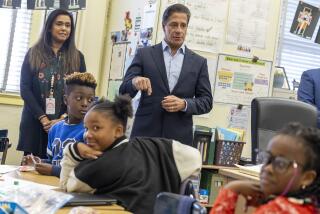LAUSD considers earlier start to school year
- Share via
An education reform gaining traction locally has nothing to do with reading or math: It’s a plan to start the school year earlier.
This change would not make the school year longer — it would just begin sooner and end sooner. The Los Angeles Unified School District hails the idea as a step forward academically, arguing that students would be better prepared for exams.
They would take first-semester exams sooner — before the winter vacation erodes that term’s learning. And the High School Exit Exam and Advanced Placement exams would come later in the academic year, after teachers had covered additional material.
The Board of Education is expected to vote on the new calendar in December. Eighteen schools already made the change this summer.
But some parents and teachers don’t want to exchange the typically temperate days of June for the scorchers of August, especially in the San Fernando Valley.
Under the plan, schools would start 15 days sooner in 2011, on Aug. 15, rather than the traditional Tuesday after Labor Day, which falls on Sept. 5. The school year would end June 1 for nearly all regular campuses within the nation’s second-largest school system.
Polytechnic High in Sun Valley is one of the schools that already has been scheduling exams before winter break. That approach is better, said student Grace Wheeler.
“It gives us time to relax during our break rather than having to study every day for the test,” said Grace, a senior.
The earlier start will also coordinate better with community college schedules for students who want to take enrichment classes, said Zsuzsanna Vincze, L.A. Unified’s administrative coordinator for school management services. And high-schoolers would be able to compete earlier for summer jobs.
Younger students wouldn’t share in these benefits, but district officials want to avoid forcing families with more than one child to juggle different schedules.
One thing is certain: The new calendar would create a hotter school year, judging by high temperature readings at the Pierce College weather station in Woodland Hills.
From 2006 to 2010, the daily high rarely dipped below 90 degrees in the period from Aug. 15 to Aug. 31. In that five-year stretch, 31 of 85 days soared to 100 degrees or higher, and another 21 days reached at least 95 degrees. For an equivalent period starting June 2, the temperature reached 100 degrees or more seven times, and 95 degrees or more an additional 12 times.
In weather 95 degrees or hotter, district policy warns school staff to look out for heat exhaustion and heat stroke while limiting, or eliminating, physical activity.
Even in September, high temperatures often limit physical activity. But August is worse, said Angel Zobel-Rodriguez, whose fourth-grader attends Van Gogh Street Elementary in Granada Hills. “And most schools don’t have indoor facilities for lunch, and recess will be unbearable.”
In e-mails to L.A. Unified, others have complained about having to alter summer plans and about having three fewer weeks of summer vacation next year during the transition to the new schedule. The first 300 e-mails ran nearly 2 to 1 against the early start. Senior administrators hope a silent majority appreciates the potential positives.
District officials had touted the advantage of having three more weeks to prepare for the state’s high-stakes standardized tests in May. Those results are used to judge the overall success and improvement of schools and school districts — and soon may be used to evaluate individual teachers as well.
But the state Education Code specifies that those tests must take place 85% of the way through the school year, plus or minus 10 days. So if students start sooner, they will take the tests sooner.
The district recently abandoned this point after teacher and parent Brent Smiley, among others, cited the state regulations.
Smiley also raised other issues, including the loss of outdoor exercise.
“We have been hearing of an obesity problem that exists in our schools, yet this new schedule almost guarantees an additional 10 to 15 … days of idleness,” Smiley wrote in an e-mail to Supt. Ramon C. Cortines. And “how many millions is it going to cost” the district to run air conditioners throughout August?
On a personal level, Smiley worries that his active 7-year-old would be “bouncing off the walls” if forced to spend all day inside, or that excessive heat outside would trigger his asthma.
The teachers union supported this year’s trial run because the faculty at each campus was willing. But if a union-wide survey reveals substantial opposition, United Teachers Los Angeles may resist a systemwide change.
In that case, “If the district attempted to impose this, which I doubt they would, they could have the early calendar but could end up with no workers,” said A.J. Duffy, the union president.
One model of early-calendar success is charter schools, which are public, independently managed and mostly non-union. Some leading charter organizations make their early starts part of a longer school year, often accompanied by a longer school day.
The extra cost is frequently offset by philanthropic support and greater spending flexibility as well as the hiring of lower-salaried teachers.
“Total instructional time,” said James Willcox, chief executive of the charter group Aspire Public Schools, “is one of the things that matter.”
For more information or to comment on the proposed calendar, go to https://tinyurl.com/earlyschool.
More to Read
Sign up for Essential California
The most important California stories and recommendations in your inbox every morning.
You may occasionally receive promotional content from the Los Angeles Times.














